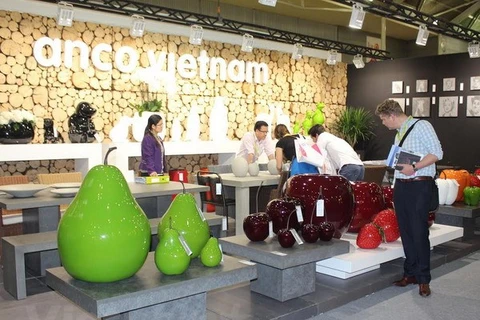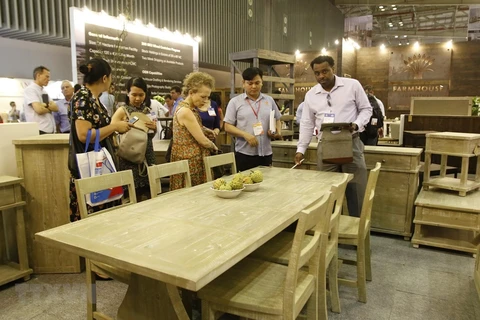HCM City (VNS/VNA) - Orders for furniture exports have risen strongly so far this year as demand has risen, according to Huynh Quang Thanh, Chairman and CEO of Binh Duong-based Hiep Long Fine Furniture Company.
“We have signed export contracts enough for the rest of the year. The world furniture market is huge and full of potential,” he said.
His company exports to many markets, with the EU, Japan, the Republic of Korea, North America and Argentina being its key markets.
Similarly, Nguyen Chien Thang, Chairman of the board of directors at Scansia Pacific Co., Ltd, which specialises in exporting indoor and outdoor furniture, said: “The export situation this year is better than last year, with our export contracts going up by 30 percent over last year.”
The US-China trade war has prompted US buyers to seek new suppliers, while existing US buyers have increased their purchase volume, resulting in a surge in orders from the US market, he said.
Huynh Van Hanh, permanent Vice Chairman of the Handicrafts and Wood Industry Association of HCM City (HAWA), said international buyers have shifted their orders with exporters from other countries, especially China, to orders with Vietnamese firms since when Vietnam signed the Comprehensive and Progressive Agreement for Trans-Pacific Partnership (CPTPP).
However, the woodworking industry has not benefited much in terms of tariff duties from CPTPP and other free trade agreements because Vietnamese furniture products are mainly exported to the US and EU markets, and import tariffs to these markets were already very low and even at zero, Thang said.
But free trade agreements have indeed spurred interest from buyers who are thinking about Vietnam for the first time, he said.
“The CPTPP will help customers feel secure when they come to Vietnam to place orders,” Hanh said.
Dien Quang Hiep, Chairman of the Binh Duong Furniture Association and General Director of Mifaco, said: “Orders are increasing in 2019 and next year. This was not due to Vietnam benefiting from the US-China trade war or the CPTPP. Even without those things, the global wood processing industry would still have naturally moved to Viet Nam, but just a little slower than now.”
The woodworking industry enjoyed good growth last year, with exports of wood and forestry products reaching 9.4 billion USD, up 16.8 percent from the previous year.
“With the current growth rate, it will not be difficult for the industry to fulfil the export target of 11 billion USD set for this year,” he said.
However, a surge in export orders is not only an opportunity but also a challenge for wood processing firms, requiring them to improve their capacity to fulfil orders.
Thang said: “The most difficult task is how to meet an increase in demand. We must expand investment in new machinery lines, which will cost millions of US dollar.”
Similarly, Thanh said his company has already invested in automating production, with the objective of increasing productivity and quality.
Hanh said that, with the market’s positive signals, many HAWA members have expanded production scale as well as invested hundreds of millions of dollars in upgrading their machinery.
Hiep said that to improve the industry’s capacity, the Government should develop concentrated industrial parks so that enterprises can gather together to create strength. These firms will link together, with each company in charge of a certain phase in the industry’s supply chain. By doing that, the industry’s productivity and production scale will increase strongly.
Thang said that the industry would not face a lack of material sources for processing furniture for export, even though orders have gone up.
“Seven to eight years ago, we used 60-70 percent of imported timber for processing furniture to export, but now imported timber accounts for only 30 percent and 70 percent is from local supply.”
Timber is a renewable material source, he noted. In developed countries, timber output has increased by 30-40 per cent compared to 30 years ago.
In addition, the Vietnamese Government has encouraged reforestation, with the forest coverage ratio now at 41-42 percent compared to 27 percent 20 years ago, he said.
Vietnam has about 4,500 wood and forest product processing enterprises, of which private enterprises account for 95 percent.
Last year, the number of enterprises processing products for export reached over 1,800, an increase of more than 300 compared to 2017.
Vietnamese timber and forest products are exported to more than 120 countries and territories. Vietnam ranks fifth in the world’s wooden product export market, second in Asia, and first in Southeast Asia.-VNS/VNA
“We have signed export contracts enough for the rest of the year. The world furniture market is huge and full of potential,” he said.
His company exports to many markets, with the EU, Japan, the Republic of Korea, North America and Argentina being its key markets.
Similarly, Nguyen Chien Thang, Chairman of the board of directors at Scansia Pacific Co., Ltd, which specialises in exporting indoor and outdoor furniture, said: “The export situation this year is better than last year, with our export contracts going up by 30 percent over last year.”
The US-China trade war has prompted US buyers to seek new suppliers, while existing US buyers have increased their purchase volume, resulting in a surge in orders from the US market, he said.
Huynh Van Hanh, permanent Vice Chairman of the Handicrafts and Wood Industry Association of HCM City (HAWA), said international buyers have shifted their orders with exporters from other countries, especially China, to orders with Vietnamese firms since when Vietnam signed the Comprehensive and Progressive Agreement for Trans-Pacific Partnership (CPTPP).
However, the woodworking industry has not benefited much in terms of tariff duties from CPTPP and other free trade agreements because Vietnamese furniture products are mainly exported to the US and EU markets, and import tariffs to these markets were already very low and even at zero, Thang said.
But free trade agreements have indeed spurred interest from buyers who are thinking about Vietnam for the first time, he said.
“The CPTPP will help customers feel secure when they come to Vietnam to place orders,” Hanh said.
Dien Quang Hiep, Chairman of the Binh Duong Furniture Association and General Director of Mifaco, said: “Orders are increasing in 2019 and next year. This was not due to Vietnam benefiting from the US-China trade war or the CPTPP. Even without those things, the global wood processing industry would still have naturally moved to Viet Nam, but just a little slower than now.”
The woodworking industry enjoyed good growth last year, with exports of wood and forestry products reaching 9.4 billion USD, up 16.8 percent from the previous year.
“With the current growth rate, it will not be difficult for the industry to fulfil the export target of 11 billion USD set for this year,” he said.
However, a surge in export orders is not only an opportunity but also a challenge for wood processing firms, requiring them to improve their capacity to fulfil orders.
Thang said: “The most difficult task is how to meet an increase in demand. We must expand investment in new machinery lines, which will cost millions of US dollar.”
Similarly, Thanh said his company has already invested in automating production, with the objective of increasing productivity and quality.
Hanh said that, with the market’s positive signals, many HAWA members have expanded production scale as well as invested hundreds of millions of dollars in upgrading their machinery.
Hiep said that to improve the industry’s capacity, the Government should develop concentrated industrial parks so that enterprises can gather together to create strength. These firms will link together, with each company in charge of a certain phase in the industry’s supply chain. By doing that, the industry’s productivity and production scale will increase strongly.
Thang said that the industry would not face a lack of material sources for processing furniture for export, even though orders have gone up.
“Seven to eight years ago, we used 60-70 percent of imported timber for processing furniture to export, but now imported timber accounts for only 30 percent and 70 percent is from local supply.”
Timber is a renewable material source, he noted. In developed countries, timber output has increased by 30-40 per cent compared to 30 years ago.
In addition, the Vietnamese Government has encouraged reforestation, with the forest coverage ratio now at 41-42 percent compared to 27 percent 20 years ago, he said.
Vietnam has about 4,500 wood and forest product processing enterprises, of which private enterprises account for 95 percent.
Last year, the number of enterprises processing products for export reached over 1,800, an increase of more than 300 compared to 2017.
Vietnamese timber and forest products are exported to more than 120 countries and territories. Vietnam ranks fifth in the world’s wooden product export market, second in Asia, and first in Southeast Asia.-VNS/VNA
VNA

























